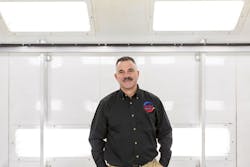Why are you in the collision repair business? Bob McSherry really wants you to think about your answer to that question. Because, more than likely, your answer has something to do with protecting drivers on the road, restoring vehicles to pre-damage condition, performing a service for your community.
But if you’re not performing diagnostic scans on every vehicle that comes through your shop before and after the repair, he’s not buying that answer.
“The simple fact is, you can change all the airbag parts you want, but the airbag light is not going to come on if the occupancy sensor isn’t calibrated,” he says. “If you send a car out the door after it’s been hit and you don’t calibrate that front-seat sensor—which Toyota, Lexus, Acura, Honda, Hyundai, Kia state has to be done—then you’re going to be liable for someone getting hurt.”
It’s that hard-nosed, no-nonsense approach to ensuring everyone’s safety that has led to incorporating pre- and post-repair diagnostic scans on every job that comes through North Haven Auto Body in North Haven, Conn. In the past year, McSherry has spent thousands on equipment and created standard operating procedures for his staff, all while improving efficiency with scanning and negotiating with insurance companies in an attempt to achieve an ROI.
SHOP STATS: NORTH HAVEN AUTO BODY Location: NORTH HAVEN, CONN. Shop Size: 18,000 SQUARE FEET Staff Size: 30 Average monthly car count: 265 Annual revenue: $8.3 million
The Backstory
After 32 years in the industry, McSherry has witnessed firsthand the evolution of collision repair, and he believes pre- and post-repair scanning is the most critical issue to hit it yet. And he’s been involved on the ground floor of it all, from discussing the issue on Mike Anderson’s business council to serving as a guinea pig for asTech’s original scanning equipment years ago to sitting on the I-CAR repairability committee, all while growing his business to $8.5 million in annual revenue in 2016.
“I’ve gotten to meet the guys from Toyota and Honda and GM and Chrysler,” McSherry says about his time serving on the I-CAR repairability committee. “I would have never thought I’d work with these businesses and have a say in them making a difference in our industry.”
The Problem
That “difference” has been pushing the importance of requiring pre- and post-repair scans on vehicles to restore all components to factory settings. Because until it becomes commonplace and standard, and until OEMs start requiring it on every vehicle, McSherry says it will be impossible to negotiate with insurance companies to achieve an ROI on the hefty scanning investment.
Over the past year, McSherry has heavily invested in scanning equipment, with his bill totaling $22,000 in 2016—in 2017, he expects to spend $27,000. And his only way of getting a proper return has been establishing an efficient scanning process and meeting halfway with insurance companies to recoup the scanning costs.
The Solution
At this point, scanning is a part of the everyday repair process at McSherry’s shop. It took time to get there, though. For you to do the same, he says you should consider the following.
The Equipment
It’s important to know what scan tools are right for your shop. Part of improving the efficiency of scanning at his shop has been having multiple tools at his shop’s disposal, McSherry says, which means heavy research is involved.
“There’s a general lack of awareness in this industry,” he says. “If you never leave your four walls, you won’t learn much.”
While you can certainly read about the various scan tools available, McSherry says he’s better able to tell if a scanner is right for his shop by physically testing it beforehand. He encourages shop owners to attend industry events and trade shows. Also, form relationships with dealerships and ask to test out their OEM equipment.
“I schedule a visit, bring a technician with me, and ask him whether or not he thinks the tool is right for us,” he says. “You can test the ease of use and the functionality.”
McSherry’s best friend has been the asTech 2 from Collision Diagnostic Services (CDS). The asTech 2 is a diagnostic tool that scans the vehicle and sends a service request to a staff of CDS technicians qualified to evaluate most makes and models.
However, he says it’s important to have factory tools as well. With most vehicles heading out of shops on Thursdays and Fridays, he says wait times can reach the one-hour mark for the report from CDS, so it’s good to have options so your technicians aren’t getting held up and leaving a vehicle idle in its bay.
On top of two asTech 2 scanners, some of North Haven’s other diagnostic equipment include the Ross-Tech VCDS (for Audis and VWs), the Honda HDS, the Toyota Techstream, and a Tesla tool.
The Process
While he’s still in the process of writing SOPs for scanning every repair, McSherry says it’s much harder to find a one-size-fits-all approach that works for every vehicle.
“You build any system for the normal, not the exception,” he says. “The only problem is we get a lot of exceptions.”
McSherry has done his best to control the elements by hiring a single technician specifically to perform any and all scans for the business. If that technician is tied up, others will jump in with one of the shop’s many scan tools to help out.
When a car comes in, the paperwork goes in a designated staging area. The vehicle doesn’t go into production until it’s scanned, which is when the paperwork can move forward.
The diagnostic technician then performs the pre-repair scan to document all fault codes and identify necessary repairs. When the car moves into teardown, it allows the technician to more clearly identify problems and perform any further scans that may be necessary. The technician notes each scan performed and the symptoms found in the labor lines.
“To keep a scan tool hooked into a vehicle the whole way through is unrealistic. You’ve got to keep coming back,” McSherry says. “You could do up to four scans on one vehicle if you get everything cleared.”
The Costs
The ROI on your investment will be slow, McSherry warns, especially depending on your vehicle makeup. If you service a lot of Toyotas or Hondas, he says those factory scanner purchases are no-brainers, and the original purchase should be recouped in no time. Evaluate your workload to determine if you take in enough OE work to justify a purchase.
Where you’ll run into more trouble, however, is with scanning prices and subscriptions. On top of equipment purchases, each scan on the asTech costs McSherry $89 to $209, and yearly subscriptions for his three different factory tools generally cost over $1,000 per automaker.
While you can see a return on your subscription/equipment costs within months, McSherry says, your ability to make up the scanning costs will depend on your ability to negotiate with insurance companies.
The Negotiation
McSherry charges $249 for a full scan, which involves a pre- and post-repair diagnostic scan and any calibrations. On top of that, he attempts to charge for any associated labor.
Your ability to negotiate a fair price will depend, of course, on the insurance company. McSherry claims the two largest insurance companies in Connecticut are very difficult to work with. However, with the more lenient insurance companies, he says education has won many of them over.
“You have to educate them. You have to show them we wouldn’t have seen this problem if we didn’t scan it ahead of time,” he says. “Especially when you get into restraint systems, adaptive headlights, adaptive cruise control, etc.”
When it comes to the tougher companies, McSherry says it’s important for his team to be diligent in its scanning processes and document every fault code that results from a scan.
“With asTech, you get a statement for each repair with fault codes on it, and I have a much easier time getting paid,” he says.
McSherry suggests listing out your scanning costs in tenths of an hour, so the heftier scans don’t stand out to insurance companies.
“You have to be very specific in how you break it down in your invoice, because they look for big numbers,” he says. “You have to spoonfeed it and tenth them to death—tenths turn into hours, and hours turn into profit.”
The Aftermath
After several months of pre- and post-repair scanning each vehicle, McSherry says scanning has become just another component of the repair process that his entire team has bought into.
McSherry says he’s been able to get insurance companies to pay for about 70 percent of his scans. After $22,000 in equipment purchases and subscription fees, he says that ability to negotiate has allowed him to recoup the scanning investment by a slim margin.
“On a Honda scan tool, you’re looking at paying $4,400 per year,” he says. “Even if you do a moderate amount of Hondas, you can pay for that in 3-4 months. Then it becomes a profit center.”
The Takeaway
While McSherry doesn’t like the fact that he has to fight insurance companies on the issue of scanning, he says the fact that scanning is an everyday occurrence at his operation allows him to sleep at night.
“It’s all what you choose to do,” he says. “At the end of the day, I want to make the industry better than when I found it. That’s the way I look at it. If that means I eat some of the costs? So be it.”

